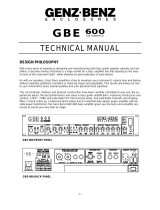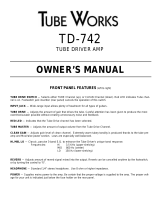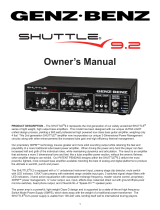Page is loading ...

DESIGN PHILOSOPHY
With many years of experience designing and manufacturing both bass guitar speaker cabinets and ampliers, it
became obvious that there is a large market for a bass amplier line that reproduces the natural tone of the
instrument itself, while allowing for personalization of tonal texture.
As with our speakers, Genz Benz ampliers are designed to maximize your instrument’s natural tone and feel
without imparting additional unwanted coloration or reducing impact and playability. This results in an amplier that
will always be true to your instrument’s basic natural qualities and your personal tonal signature.
The circuit design, features, and physical construction have been carefully developed to give you, the experienced
player, the best performance in bass guitar amplication. Featuring sturdy jacks and controls, premium 12AX7 TUBE
and solid state FET front end pre-amps, tuner output, mute switch, active/passive switch, foot switchable channels
and shaping lters, dual 5 band active EQ, balanced direct output, and an industrial duty bipolar power amplier with
toroidal power transformer. The Genz Benz GBE 1200 bass amplier gives you the tools and versatility necessary to
sound your very best on stage.
TECHNICAL MANUAL
1

TECHNICAL INFORMATION
The rst stage of the GBE 1200 preamp uses a low noise BI-FET linear scaling amplier with a 2 pole low cut point
at 23 Hz to prevent excessive speaker cone excursion and intermodulation distortion. Additional bandwidth roll-off is
provided at 20 KHz for RFI suppression. Additional front end control is provided with the active/passive gain switch,
signal mute switch and pre-mute tuner output jack. The variable gain stages are a feedback-divider type control, one
of which is all solid state and the other utilizing a 12AX7 dual triode tube, each providing a maximum gain of about
30 dB. On the tube stage, variable non-linear loading creates a smooth, musical sounding overdrive rich in
harmonics. These foot-switchable and blendable gain stages feed 3 foot-switchable, user adjustable signal shap-
ing lters, multiple effects loops and the dual 5 band active equalizers. These EQ lters provide over 15dB of boost
and cut, with the center position being at. The output amplier feeds the master volume control and fully protected
power amplier. A low noise differential drive output amplier is provided for the direct output (switchable level, pre/
post EQ and ground lift) and is phantom power protected.
The power section consists of a low distortion bipolar power amplier with integrated limiter which allows gradual,
controlled overload without sudden loss of feedback that would result in loss of control of the speakers. The output is
rated at 550 watts RMS at 8 ohms, 1000 watts RMS at 4 ohms, and 1200 watts RMS at 2 ohms, using a burst rating
ten times more stringent than typical industry standards. The amplier topology is fully symmetrical dual-differential
low feedback class A-B with automatic servo control of bias and DC offset. Additional performance headroom is
gained by matching the power supply to the load impedance using the POWERFLEX impedance selector switch on
the back panel.
Also provided is sophisticated on board dual slope integrated VI output stage protective limiting, unique rail detector
short circuit protection enhancements, solid state thermal protection sensing, short circuit load protection, DC fault
protection and RFI suppression. All amplier status points are indicated on a dual color LED array. This amplier
uses heavy duty copper based bi-polar power transistors directly mounted via our “nerf bar” clamping system to a
variable speed fan cooled extruded aluminum heatsink tunnel. It is immediately apparent that this is a serious ampli-
er, as the output section sports 12 output transistors with a combined rating of 2400 watts and 192 amps to insure a
conservative and reliable design.
An important and not commonly discussed specication is a power amplier’s ability to deliver it’s rated power into a
reactive or low impedance load without premature engagement of the amp’s protective VI limiting circuitry. All
speakers present a reactive load to the amplier, reducing real world driving ability. The power section of the GBE
1200 amplier is rated to deliver full power into a reactive load with a 45 degree (leading or lagging) power factor
phase angle. This is one important reason why all Genz Benz ampliers sound so big!
FEATURES
The following feature set is included on the GBE 1200 bass amplier. These features were developed based on
usability and are the result of input from veteran players from around the country. It is important for an amplier to
reect the real needs of the players using them. We feel that this amplier does just that.
FRONT PANEL
Input — The ¼” instrument Input has switchable sensitivity. With the switch in the passive position, the preamp
presents a higher gain, which is tailored to the characteristics of passive pickups. A passive magnetic pickup
consists basically of a permanent magnet called a pole piece with a wound wire coil around it. The GBE 1200’s input
impedance is set high enough to prevent interaction with the high output impedance of all commonly used passive
2

pickups. With the switch in the active position, the preamp presents a lower gain (approx –10db) which is tailored to
active pickups. A bass with active pickups is essentially one that offers extreme exibility in it’s onboard tone control
and utilizes a battery in order to power the active electronics of the bass preamp to increase the signal of the lower
impedance pickup. SPECIAL NOTE-In the past several years many bass instrument manufactures have begun of-
fering preamps with hot to very hot signals. The result is that the instruments’ onboard electronics and the amount of
cut and boost used on the instrument could dramatically affect how you set your gain and EQ controls on any bass
amplier, including the GBE 1200.
Input Signal Mute Switch — The input section also includes an “input mute” switch. With this switch, you can place
the amplier (and the direct output) in standby mode between sets without having to change any of your volume
settings. This feature is especially handy when using the tuner output since you will still be able to use your tuner
without having sound come from the amplier or P.A. system. A red LED turns on when the input mute is active,
reminding you that you are in “stand-by” mode.
Channel and Mix Switches — The “TUBE/FET” switch in the channel section switches the preamp between the
tube preamp and the FET preamp. The ”mix” switch in the channel section combines the two preamp channels
together. The mix switch must be disengaged (out) for the “TUBE/FET” channel switch to operate. Each preamp has
it’s own sound and character. Alternating between the two distinct voicings allow for creative exibility in obtaining
your tone. Additionally, mixing the two channels together yields additional tonal possibilities. Bright blue tally LED’s
show at a glance which mode you have selected. Both switches must be in the out position in order for the 5 button
footswitch to work properly.
FET Channel Input Gain Control & O/L LED — The “FET GAIN” control, in conjunction with the red “O/L LED”
(overload), allow you to adjust the FET preamp input gain sensitivity to the instrument you are playing. Basses
can have an output level from a few thousandths of a volt to several volts. Generally, you want to see only an
occasional ash of the red O/L LED when you really hit the string hard. Distortion of the preamp gain stage will occur
when the red O/L LED is illuminated constantly, so plan accordingly. The best signal to noise ratio will result with the
above method. Setting your playing volume in the FET channel will be a combination of the “FET GAIN” control, the
“FET VOLUME” control and the “MASTER VOLUME” control, depending in part on individual preference. A blue LED
lights when the FET channel is active.
TUBE Channel Input Gain Control & O/L LED — The TUBE channel operates the same as the FET channel,
except that it is more often desirable to operate the “TUBE GAIN” control higher, intentionally overdriving the tube
preamp for a more overdriven and distorted sound. This action is indicated visually by the red “O/L LED” and
generally requires a higher setting on the “TUBE GAIN” control and a lower setting on the “TUBE VOLUME” control.
A blue LED lights when the TUBE channel is active.
SETTING YOUR INPUT SIGNAL – Use the following guidelines to set your amplier input stage for the type of bass
used and your personal playing style.
1) Select either Active or Passive input gain depending upon the bass used.
2) Set your instruments controls (volume and tone) where you normally prefer to run them.
3) With the Channel Gain setting at “0” and your amplier EQ positions centered at 12 o’clock, begin
turning the gain control up to a level in which the O/L LED is illuminating with your hardest notes
played. It is okay for the O/L LED to ash occasionally BUT it should not be on constantly.
Now set your channel volume and master volume settings for the desired output level (loudness)
that you wish to produce.
4) Now, turn your attention to the EQ section and make the adjustments for the desired tone. Because
this is an active EQ network any large settings of cut or boost will affect the gain level of the preamp
and the O/L lights at the input stage.
5) After setting your EQ it may be necessary to go back and adjust your input gain level accordingly. It
should be noted that the Global Signal Shape circuits will not affect the input gain BUT will affect the
Master output level and clip indicator if used with extreme settings.
Note—due to the exibility of the GBE 1200’s channel selecting and mixing capabilities BOTH channels O/L LED’s
may illuminate even though you are only playing one channel. This feature allows you to know that signal is active in
both channels and the second channel’s gain level is set at a predetermined level (by you) before you switch to it or
mix it in.
Active 5 Band Equalization — The “active 5 band equalization” used in the GBE 1200 amplier is composed of 1
shelving low frequency control, 3 peaking midrange controls and 1 shelving high frequency control. These lters are
not interactive and are effective as an advanced tone control system. The lters have a cut/boost range of +/- 15dB
3

and a smooth, musical sounding response. A separate 5 band equalizer is provided for each the TUBE and the FET
channels. This fully active EQ has a wide range, so generally, a little EQ goes a long way.
Low Frequency - 80 Hz and below
Low-Mid Frequency - 250 Hz
Mid Frequency – 650 Hz
Global Signal Shaping Switches and Controls — There are 3 separate shaping lters on the GBE 1200. The “L.F.
EXTEND” (low frequency extend) lowers the low frequency roll-off response of the preamp (between 30 and 45 Hz)
to allow the full effect of 5+ string and extended scale instruments. The amount of extension is adjustable depending
on the setting of the corresponding control. Use this function with care due to the power of this amplier. The “MID
SCOOP” function introduces a midrange scoop at approximately 450 Hz, with a lower “Q” than typical equalization
provides. The amount of scoop is adjustable with the corresponding control. The “H.F. ATTACK” (high frequency
attack) function increases brightness and sparkle (approximately 4 KHz) of the signal, allowing exaggeration of
percussive effects and string sound. The amount of attack is adjustable with the corresponding control. All 3 lters are
footswitchable with the 5 button footswitch. A bright blue LED located above each switch indicates when the lter has
been selected. All switches must be in the out position in order for the 5 button footswitch to work properly.
Master Volume — The “master volume” adjusts the signal level sent to the power amplier. Best results are usually
obtained when this control is set between the 9 o’clock and 3 o’clock positions.
Output Limiter — The “output limit ” switch engages the internal power amplier’s soft clip limiter. This limiter allows
simulation of tube output stage saturation as the amplier nears its maximum power. The limiting action is particularly
musical sounding, even when driven hard. A bright blue LED located above the switch indicates when this feature has
been selected.
Master Section Status Indicators —
• The “POWER JEWEL LIGHT” indicates that the amplier is on and the low voltage power supplies are active.
• The red “PROTECT LED” indicates that the amplier is in “protect” mode and the output relay is de-energized. This
LED will illuminate for approximately 3 seconds during power switch-on and switch-off. It is normal for this LED to glow
while continuing to monitor the internal conditions for a few seconds after the protection relay has closed. It will also
illuminate during any internal fault condition. If this happens, turn the amp off and consult a repair technician.
• The red “THERMAL LED” indicates that the amplier has overheated, engaged the protection circuit, and shut down.
This circuit is self-resetting when the offending condition (blocked air vents, foreign body stuck in fan, etc) is corrected.
• The amber “2 OHM LED” indicates that the power amplier’s 2 ohm POWERFLEX mode has been selected. This
LED monitors the operation of the high voltage power supplies.
• The blue “SIGNAL LED” indicates that the power amplier is receiving signal (over several watts output) and all is
well!
• The red “CLIP-LIMIT LED” indicates that the power amplier is near its maximum power and/or the limiter threshold
has been crossed. Driving approximately 6dB beyond this point with the “OUTPUT LIMITER” engaged will cause the
amplier to gradually begin to clip.
4
High-Mid Frequency – 1650 Hz
High Frequency - 4000 Hz and above

BACK PANEL
Tuner Output Jack — The “TUNER OUTPUT” jack is provided to allow a tuner to remain plugged into the amplier
while playing. This output remains active when the “MUTE” switch is pressed, allowing for tuning your instrument
while not sending signal to either the “DIRECT OUTPUT” or the speaker. The tuner out signal will drive all known
tuners. The front panel jack is in parallel with the rear panel jack allowing for convenient connection to a rack mount
tuner.
Effects Loop Jacks — The serial “EFFECTS LOOP” jacks are provided to allow access to the signal for the
purpose of inserting signal processing equipment such as compressors, chorus, delay & reverb processors.
Individual pre-EQ loops are provided for the TUBE channel and the FET channel. An additional post EQ loop is
provided for the post-EQ summed (TUBE + FET) signal. This loop may also be used as a preamp output – power
amp input patch point. “SEND” (output) and “RETURN” (input) are nominal +4 dB level. “Series” devices (such as
compressors and gates) require that the signal ow out from the send jack on the amplier, through the processing
device, and back into the return jack on the amplier. Parallel or mixed signal devices (such as chorus, delay, and
reverb processors) require that the signal ow out of the send jack on the amplier, through the unit where it is split
into a dry (unaltered) signal and a wet (processed) signal. On the processing unit, you will use the mixed signal
output to return the signals (both wet and dry) to the return jack on the amplier. The ratio between the wet signal
and the dry signal is heard as the amount of effects added back to the original signal, which is controlled by the mix
knob (also called “balance”) on the effects processor. This may be a real knob (as in the Alesis® Microverb), or
software controlled (as in the Yamaha SPX-90, SPX900 or SPX 990). Set the input sensitivity on the effects
processor according to the manufacturer’s instructions. An additional “slave output” jack is provided, and may be
used as an auxiliary output to drive a direct box, additional amp, tape deck etc. This output is summed (TUBE +
FET) post - equalization, and pre master volume. The “MUTE” switch will shut all of these outputs down when en-
gaged.
POWER FLEX Switch— This switch allows optimum matching of the power supply to the speaker load. Similar in
concept to output transformer matching in tube ampliers. This feature allows the GBE 1200 to drive 2 ohm loads at
maximum efciency compared to more traditional designs. Driving 2 ohm speakers with the switch in the 4-8 ohm
position is not recommended as the amp’s monitoring circuitry may reduce the output power to minimize stress on
the amplier. Operating the amplier with the switch in the 2 ohm position into a 4 or 8 ohm load is not a problem,
and may be benecially used to scale the power of the amp down when playing small clubs that offer limited stage
power. An amber “2 ohm” indicator LED is provided on the front panel to conrm that the 2 ohm POWERFLEX mode
has been selected.
Fan Control — The GBE 1200 is a fan cooled high powered rack mount device. A continuously variable, side panel
mounted fan is utilized. This allows for quiet operation at low output levels and greater cooling capacity when playing
at high output levels or under high ambient temperature conditions. Be sure not to block the intake or exhaust vents
when mounting your amp. Specically, beware of “gig-bag” type racks that offer no side clearance.
Direct Output — The GBE 1200 includes a studio quality, fully active transformerless balanced, phantom power
protected “DIRECT OUTPUT”. Recessed switches are provided to customize this output to your needs.
With the “PRE/POST” switch in the “PRE” position, the direct output receives its signal directly from the pre-amp
input buffer amplier with no tonal modications. This is a pre gain control, pre-EQ output, with the best signal to
noise ratio and the least possible signal coloration. Most recording and sound reinforcement companies will want to
use this position since changes you make to your stage sound will not affect this output.
With the “PRE/POST” switch in the “POST” position, the direct output receives its signal from the summed (TUBE
+ FET) output of the 5 band equalizers, but pre-master volume. This feature allows for additional exibility in some
situations.
A “GROUND LIFT” switch is provided which opens pin 1 (shield) on the direct output to prevent ground loops. Use
the position that results in a minimum of noise (hum or buzz).
A “LEVEL” switch provided to allow selection between nominal mic (-30dBu) and line (+4dBu). Generally, the signal
in the “PRE” position will be somewhat lower than in the “POST” position.
Foot Switch — The GBE 1200 is tted with a 6 pin DIN jacks for the 5 button footswitch (included). In order for the
footswitch to function correctly, the amplier’s front panel switches for these functions must be in the “out” position.
This footswitch is unique to Genz Benz due to the complex nature of it’s functions and must be factory supplied.
5

GENERAL SAFETY INFORMATION
Power is supplied to the amplier through an IEC type detachable cord set. The main fuse (and a spare) is located
in a slide-out drawer in the bottom half of the IEC connector. See the fuse chart on the back panel of the
amplier for information pertaining to your country’s supply voltage. The mains connector, fuse holder, and power
supply are internationally rated at 115/230 volts - 50/60 Hz. An Australian specic 240 volt version is also available
and is distinguished by a label on the rear of the unit. For our international touring players, an external mains line
voltage switch is provided, with a fuse size chart printed on the rear of the unit denoting the power supply
conguration and fuse size that the unit has been rated for. International IEC type cord-sets are available for a
variety of international power supply sockets.
Common sense (as well as the law) dictates that you do not operate the unit where it will be exposed to moisture or
rain, excessive ambient heat (over 110 degrees F / 40 degrees C) or without a properly grounded A.C. power source.
Never remove the ground pin from the A.C. power connector.
Ventilation is required to keep this amplier from overheating. Do not block air ow over heat-sinks at the rear of the
unit.
SAFE OPERATING REQUIREMENTS:
•Never set an amplier on anything that will tip over or collapse under its weight.
•Provide a minimum distance of 25.4 mm (1 inch) around all sides of the amplier for sufcient ventilation. The
ventilation should not be impeded by covering the amplier’s vent openings with items such as newspapers,
table-cloths, curtains, etc.
•No naked ame sources, such as lighted candles, should be placed on the GBE 1200 amplier.
•This amplier should not be exposed to dripping or splashing and no objects lled with liquids, such as vases or
drinks, should be placed on this product.
•The GBE 1200 amplier should be connected to a mains socket outlet (power receptacle) with a protective earth
(ground) connection at all times.
•The ampliers mains plug (power plug) is considered the disconnect device and the connection must remain
accessible at all times.
•This amplier is capable of producing sound pressure levels that may cause hearing loss.
•There are no user serviceable parts and hazardous operating voltages are present inside this unit. Always consult a
qualied repair facility for service.
6
Output Jacks — The GBE 1200 features 2 Neutrik Speakon™ NL-4 connectors. Minimum recommended total load
impedance is 2 ohms with the POWERFLEX switch in the 2 ohm position. The “Speakon” is wired using pins 1+ and
1-. Pins 2+ and 2- are not connected. Traditional ¼” speaker jacks are not provided due to the high output power of
this unit!
Specications
Rated Power: 550W/8ohms; 1000W/4ohms; 1200W/2ohms
Dimensions: 5.25”H X 19”W X 15”D
Weight: 42 LBS

7811 E. Pierce St. Scottsdale, AZ 85257
Ph: 480-941-0705 Fax: 480-946-2412
www.genzbenz.com
DECLARATION OF CONFORMITY
(89/336 EEC-EMC DIRECTIVE)
Manufacturer’s Name: Genz Benz, a division of KMC Music Company
Manufacturer’s Address: 7811 East Pierce Street
Scottsdale, AZ 85257, U.S.A.
Product Type: Audio Amplier
Model Number: GBE 1200
Operating Power Condition: 115/230VOLT, 50/60 Hz
Effective Date: 01-01-2006
Conforms to the Following Standards: [X] EN 55013: 2001 + A1: 2003
[X] EN 55020: 2002 + A1: 2003
[X] EN 60065
[X] IEC 61000-3.3: 1994 + A1: 2001
[X] IEC 61000-4.2
[X] IEC 61000-4.3
[X] IEC 61000-4.4
[ ] FCC 47CFR Part 15-B, Class B
[X] RoHS Directive 2002/95/EC
[X] WEEE Directive 2002/96/EC
[X] CE Mark LV Directive 73/23 EEC
WARNING!
•The use and operation of this device constitutes an agreement of full release of any and all liability connected with its
use. Only persons familiar with the operation of high-powered professional audio equipment should attempt to operate
this device.
•In addition, by use of this device, the user agrees to hold Genz Benz and its designers, sales agents and all other
afliates and related parties harmless in the event of any accident, injury, damage or loss resulting from such use.
•Manufacturer’s sole responsibility is to provide a warranty on the specied performance of the product under normal
operating conditions for a period of 3 years.
WARRANTY:
•Genz Benz warrants the model GBE 1200 to be free from defects in materials and workmanship for a
period of 3 years from the date of purchase, when purchased from an authorized Genz Benz dealer.
•This warranty does not cover normal wear and tear incurred from the normally designed use of the product.
•This warranty is effective only if a copy of the original sales receipt is presented at the time of warranty service
•This limited warranty is completely transferable to any subsequent buyer as long as the original sales receipt is also
transferred to such subsequent buyer.
•All warranty service must be performed by a Genz Benz authorized service center.
•Before returning any unit for service, a returned merchandise authorization number (RMA#) must be obtained by calling
480-941-0705
• This warranty is valid in the US and Canada only. For all products sold outside the USA, warranty is handled through
our international distributor for each country. For more information visit our website www.genzbenz.com
A KMC Music Company, Bloomeld, CT
REV. 5
7
/







